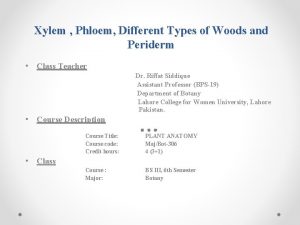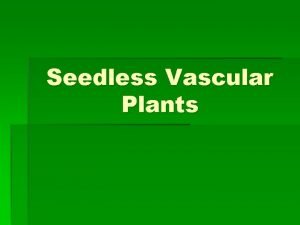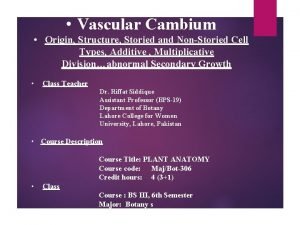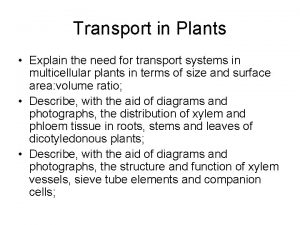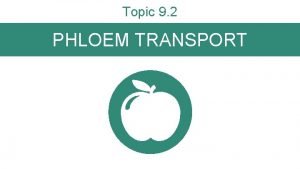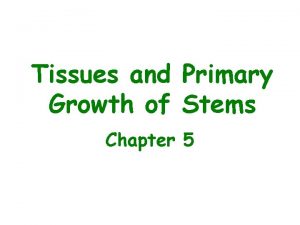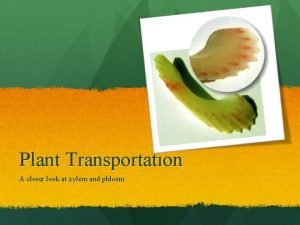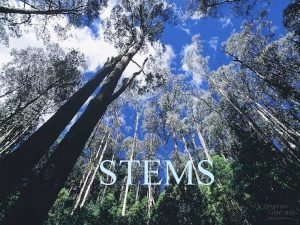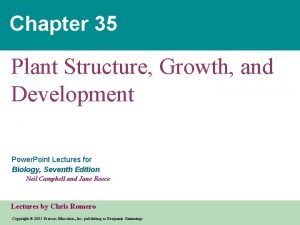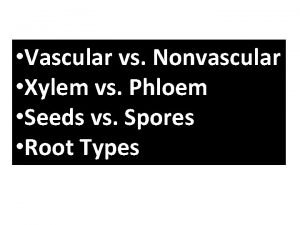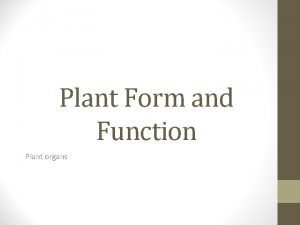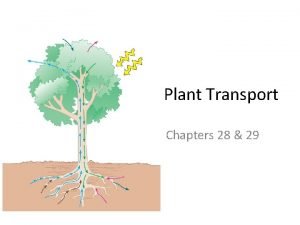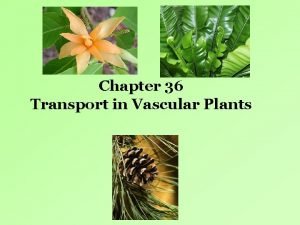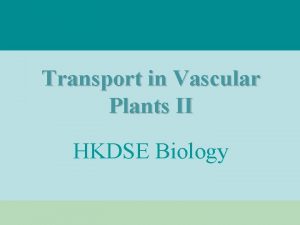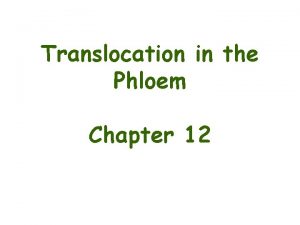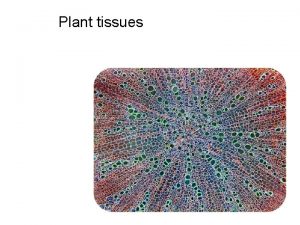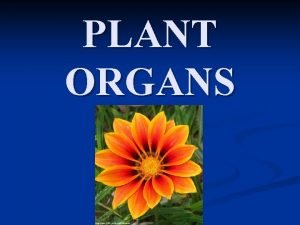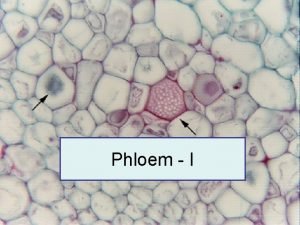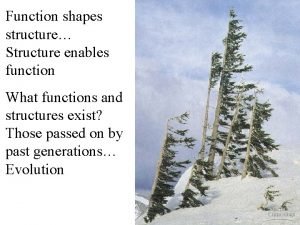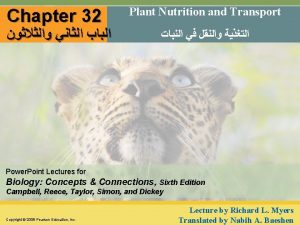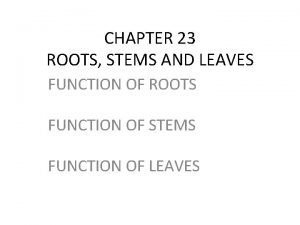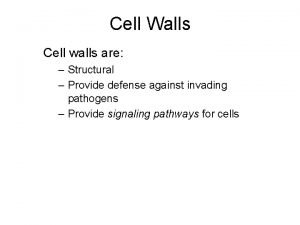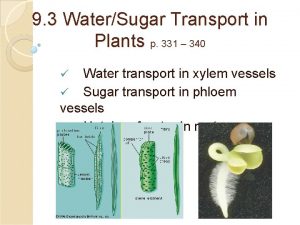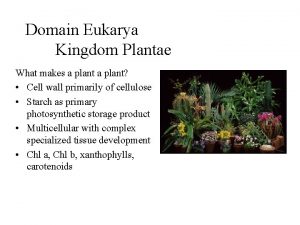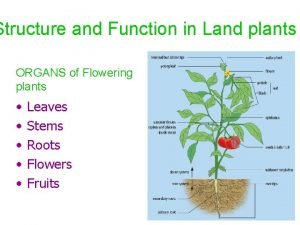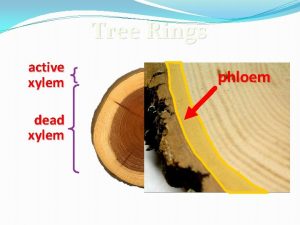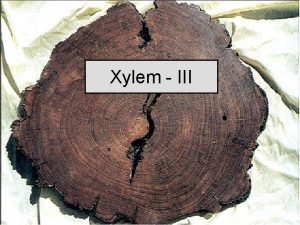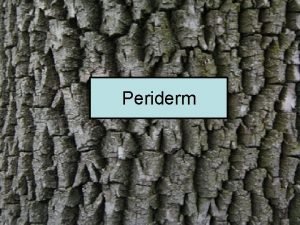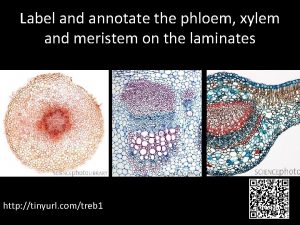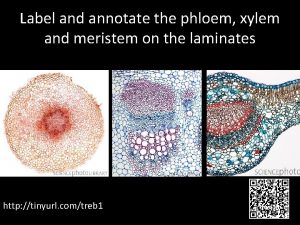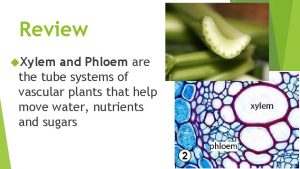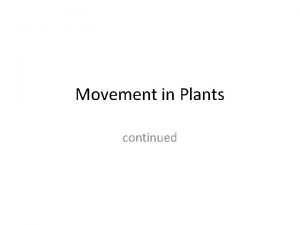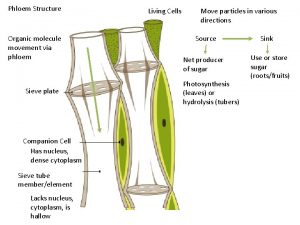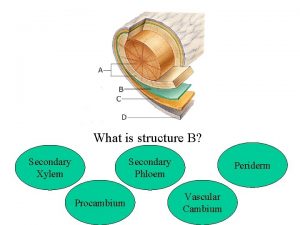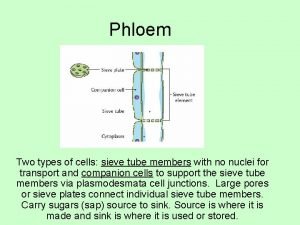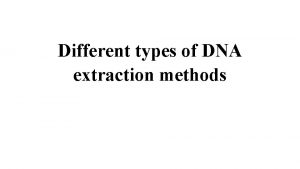Xylem Phloem Different Types of Woods and Periderm

































- Slides: 33

Xylem , Phloem, Different Types of Woods and Periderm • Class Teacher Dr. Riffat Siddique Assistant Professor (BPS-19) Department of Botany Lahore College for Women University, Lahore Pakistan. • Course Description Course Title: Course code: Credit hours: PLANT ANATOMY Maj/Bot-306 4 (3+1) Course : Major: BS III, 6 th Semester Botany • Class

Vascular bundle • A vascular bundle is a part of the transport system in vascular plants. The transport itself happens in vascular tissue, which exists in two forms: xylem and phloem. Both these tissues are present in a vascular bundle, which in addition will include supporting and protective tissues. • Vascular plant are also called “Tracheophyta” (Trachaea=vessel a component of plant and phyta means =plant). • Vascular bundle is divided into two main components : 1. xylem 2. phloem

Xylem • The term xylem was proposed by the Nageli(1858). • He derived the word from a Greek word • “Xylos” meaning wood , The main function of xylem to conduct water and minerals from root to leaves. Xylem plays an essential ‘supporting’ role providing strength to tissues

Components of Xylem 1. Tracheides 2. Vessles 3. Xylem fibres 4. Xylem paranchyma • Tracheides • These are fundamental cells of xylem. These are elongated tube like cells with tapering ends. the cells are non living at their maturity and mature cells are empty without protoplast.

Patterns of secondary thickening in tracheids: (a). Annular thickening: (b). Spiral thickening (helical thickening): (c). Scalariform thickening (ladder like thickening): . (d). Reticulate thickening (net like thickening): (e). Pitted thickening:

Patterns of secondary thickening

Vessels • Composed of short and tube like cells. • Components of vessels are called vessel segments or vessel element. • Non living and having no chloroplast. • They have shorter in length than tracheids. • They have perforation plate and pits.

Types of perforation in vessels: • Simple perforation plate: a plate with single perforation (advanced type) • Multiple perforation plate: many perforations • Scalariform perforation plate: a multiple perforation plate with perforations arranged in parallel series. • Reticulate perforation plate: pores arranged in reticulate fashion. • Forminate perforation plate: pores are almost circular.

Types of perforation in vessels Source: http: //www. biologydiscussion. com/essay/plant-tissuesessay/permanent-tissues-in-plants-essay-plant-anatomybotany/76998

Xylem fibers: • xylary fibres. • Similar to tracheids and vessels, they are also dead cells, do not contain protoplast at their maturity. • They have thick lignified secondary cell wall. The main function is to provide mechanical support. • Types of fibers • Fibre tracheids • Libriform fibers • Gelatinous fibers

Fibers types • Fibre tracheids are longer than tracheids and they have apical intrusive growth. • Libriform fibres are highly specialized fibres. They have simple pits on their walls. • Gelatinous fibres are special category of xylem fibre found in the tension wood. Gelatinous fibres are highly hygroscopic and they can absorb and store plenty of water.

Xylem Parenchyma • Only living component in xylem. • They have thin cellulosic cell wall. • Parenchyma in the xylem can store starch, oil. • • Types of parenchyma in xylem: Axial parenchyma is originated from the elongated fusiform initials of the cambial cells. • Ray parenchyma: Ray parenchyma originated from the ray initials of the cambium. • In many plants Axial and ray parenchyma cells develop protrusions that enter the tracheary cell, these outgrowths are called Tyloses

Primary xylem and secondary xylem • Primary xylem is formed during the primary growth of the plant. It is derived from procambium (a meristem) and consists of two parts namely Protoxylem and Metaxylem. • Secondary xylem formed during secondary growth of plants. it is developed from vascular cambium. • Main function is the conduction of water and mineral in the secondary plant body.

Phloem • Food conducting tissue in vascular plants. • Term introduced by Nageli in 1853. • Word derived from greek word phloiose meaning bark.

Position of Phloem • Usually outside the xylem. • In leaves phloem present lower side. • Bicollateral vascular bundle. • Internal phloem. • External phloem. • Interxylery phloem. • Concentric phloem. • Forminate phloem

Components of phloem • Sieve elements • Companion cells/ Albuminous Cells • Phloem parenchyma • Phloem fibers and sclereids

Sieve elements • Food conductimg cells. • Living with protoplasm. • Nucleus is absent. • Lignified secondary cell wall is absent. • Types: • Sieve cells • Sieve tubes

Companion cells • Specialized parenchyma cells associated with sieve tubes of angiosperms are called companion cells, while albuminous cells are in gymnosperms. • No may varies. • They are narrower then sieve tube cells. • Contain large and prominent nucleus. • Connected through plasmodesmata. • Contain plastids and ribosomes • They are metabolicaly active. • Absent in lower plants

Phloem fibers and sclereids • They are dead cells • Having lignified secondary call wall. • Having simple and slightly bordered pits. • Phloem Fibres are also called bast fibers.

Phloem fibers and sclereids Souce: https: //www. plantscience 4 u. com/2016/04/d ifference-between-fibres-and-sclereids. html

Xylem and Phloem For detailed and better understanding have a look at https: //myflyingboxandme. blogspot. com/2019/1 2/xylem-complex-tissue-diagram. html

Classification of phloem Primary phloem: • Arise from procambium. • Protophloem • Metaphloem Secondry phloem: • Arise from vascular cambium.

Functions of phloem § Conduction of food material. • Phloem fibers provide mechanical support. • Ray parenchyma store ergastic material. • Phloem fibers are source of bast fibers.

Annual Rings • The yearly or annual growth appears in the form of distinct rings which are called annual rings. • Annual rings are formed due to sequence of rapid growth (favourable season, e. g. , spring), slow growth (before the onset of un favourable period, e. g. , autumn) and no growth (un favourable season, e. g. , winter). Annual rings are not distinct in tropical areas which do not have long dry periods. • Annual Rings indicate the wood formed in a single year. It consists of two types of wood, . spring wood and autumn wood • The spring or early wood is much wider than the autumn or late wood. It is lighter in colour and of lower density. Spring wood consists of larger and wider xylem elements. • The autumn or late wood is dark coloured and of higher density. It contains compactly arranged smaller and narrower elements which have comparatively thicker walls. In autumn wood, tracheids and fibres are more abundant than those found in the spring wood.

Annual Rings • Annual rings give the age of the plant. • The annual rings also give some clue about the climatic conditions of the past through which the plant has passed. • Dendrochronology is the science of counting and analyzing annual growth rings of trees. Source: https: // www. qs study. co m/biolo gy/expla informatio nannualring

Softwood and Hardwood • Softwood is the technical name of gymnosperm wood be causeit is devoid of vessels. Several of the softwoods are very easy to work with (e. g. , Cedrus, Pinus species). However, all of them are not ‘soft’. The softness depends upon the content of fibres and vascular rays. 90 95% of wood is made of tracheids and fibres. Vascular rays constitute 5 10% of the wood. • Hardwood is the name of dicot wood which possesses abundant vessels. Due to the presence of vessels, the hardwoods are also called porous woods. In Cassia fistula and Dalbergia sisso the vessels are comparatively very broad in the spring wood while they are quite narrow in the autumn wood. Such a secondary xylem or wood is called ring porous. • In others (e. g. , Syzygium cumini) larger sized vessels are distributed throughout spring wood and autumn wood. This type of secondary xylem or wood is known as diffuse porous. Ring porous wood is more advanced than diffuse porous wood as it provides for better translocation when the requirement of the plant is high.

Softwood and Hardwood

Sapwood and Heartwood • The wood of the older stems (dalbergia, Acacia) gets differentiated into two zones, the outer light coloured and functional sapwood or alburnum and the inner darker and nonfunctional heartwood or duramen. The tracheids and vessels of the heart wood get plugged by the in growth of the adjacent parenchyma cells into their cavities through the pits. These ingrowths are called tyloses • Ultimately, the parenchyma cells become lignified and dead. Various types of plant products like oils, resins, gums, aromatic substances, essential oils and tannins are deposited in the cells of the heartwood. These substances are collectively called extractives. They provide colour to the heartwood. They are also antiseptic. The heartwood is, therefore, stronger and more durable than the sapwood. • It is resistant to attack of insects and microbes. Heart wood is commercial source of Cutch (Acacia catechu), Haematoxylin (Haematoxylon campechianum), Brasilin (Caesalpinia sappan) and Santalin (Pterocarpus santalinus). Heart woodis, however, liable to be attacked by wood rotting fungi. Hollow tree trunks are due to their activity. • Source: http: //www. biologydiscussion. com/stems-2/dicotstem/secondary-growth-in-dicot-stem-with-diagram/70397

Sapwood and Heartwood

Periderm • Periderm is a component of secondary growth that is formed towards the surface of stems and roots, having phellem, phellogen and phelloderm. • Due to increase in girth and prevent harm on the rupturing of the outer ground tissues due to the formation of secondary vascular tissues, dicot stems produce a cork cambium or phellogen in the outer cortical cells. Rarely it may arise from the epidermis, hypodermis or phloem parenchyma. • Phellogen cells divide on both the outer side as well as the inner side (bipolar) to form secondary tissues. The secondary tissue produced on the inner side of the phellogen is parenchymatous or collenchymatous. It is called secondary cortex or phelloderm.

• Phellogen produces cork or phellem on the outer side. It consists of dead and com pactlyarranged rectangular cells that possess suberised cell walls. The cork cells contain tannins. Hence, they appear brown or dark brown in colour. The cork cells of some plants are filled with air e. g. , Quercus suber (Cork Oak or Bottle Cork). The phelloderm, phellogen and phellem together constitute the periderm • Cork prevents the loss of water by evaporation. It also protects the interior against entry of harmful micro organisms, mechanical injury and extremes of temperature. Cork is light, compressible, nonreactive and sufficiently resistant to fire. • It is used as stopper for bottles, shock absorption and insulation. At places phellogen produces aerating pores instead of cork. These pores are called lenticels. Each lenticel is filled by a mass of somewhat loosely arranged suberised cells called complementary cells.

Periderm Source: https: //www. qsstudy. com/biology/f ormation-periderm-plants

 Types of xylem and phloem
Types of xylem and phloem Life cycle of seedless plants
Life cycle of seedless plants Cristina agave
Cristina agave Xylem and phloem meaning
Xylem and phloem meaning Xylem tissue structure
Xylem tissue structure Phloem function
Phloem function Lateral meristem
Lateral meristem Xylem and phloem
Xylem and phloem Xylem und phloem
Xylem und phloem Apical meristem
Apical meristem Spore vs seed
Spore vs seed Cambium phloem xylem
Cambium phloem xylem Cladode
Cladode Plasmodesta
Plasmodesta Is xylem apoplast and symplast
Is xylem apoplast and symplast Exarch and endarch condition of xylem
Exarch and endarch condition of xylem Source to sink phloem
Source to sink phloem What does phloem transport
What does phloem transport Transport in plants
Transport in plants Münch
Münch Function of sieve plate
Function of sieve plate Plant tissue
Plant tissue Phloem in plants
Phloem in plants Idioblast
Idioblast Phloem
Phloem Phloem
Phloem Function of stems
Function of stems Xylem
Xylem Phloem
Phloem Phloem
Phloem Plants
Plants Absorption and movement of water in root cells
Absorption and movement of water in root cells Xylem
Xylem Quizlet
Quizlet
